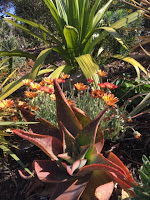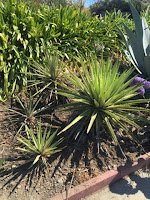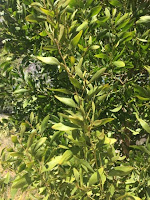Latin name: Bulbine frutescens ("BUHL-bin-ee froo-TESS-ens")
Common name: Bulbine, Cat's Tail, Jelly Burn Plant
Originally from: Southern Africa (South Africa, Lesotho, Swaziland).
Blooms: Orange and yellow flowers are held above the foliage in late spring/early summer.
Light: Full sun to part shade
Water: Although a succulent they seem to prefer occasional water over the summer.
Height x width: 18"x24"
Zones: 8-11
Where to find in P. Garden: We have some dotted around the left bed and brights bed.
The genus Bulbine has about 80 species, which are found mostly in Southern Africa, with a few species extending into tropical Africa, about six in Australia and some in Yemen.
We have two types of the same species, and we used to think one of them was the related genus, Bulbinella. However, it's easy to tell the difference: in Bulbine, the flowers have a fluffy look to their middles. By contrast, Bulbinella are smooth, as they are in most other flowers.
 Bulbine frutescens is a nice little perennial with succulent, finger-shaped leaves and lovely delicate yellow flowers. We also have an orange and yellow version.
Bulbine frutescens is a nice little perennial with succulent, finger-shaped leaves and lovely delicate yellow flowers. We also have an orange and yellow version.It's mostly dormant in summer, blooming in the spring, and then again somewhat in fall. It can be propagated easily by stem cuttings which can be planted immediately and kept in a shady area. They do not need any special attention or treatment, and build strong roots in a couple of months.
| Bulbine in San Diego |
Plantzafrica.com says:
"The fresh leaf produces a jelly-like juice that is wonderful for burns, rashes, blisters, insect bites, cracked lips, acne, cold sores, mouth ulcers and areas of cracked skin. This plant is ideal to grow and is a useful first-aid remedy for children's daily knocks and scrapes. The Rastafarians make an infusion of a few fresh leaves in a cup of boiling water. The strained drink is taken for coughs, colds and arthritis."
These plants prefer full sun, but they will also grow in semi-shade for part of the day. At PG it needs a bit of water - I wouldn't call it really xeric but rather "pretty drought tolerant," and I have to put it places where it will be somewhat damper for it to look good - in the wild some of them grow in quite damp places. It multiplies rapidly in the right conditions. Prune it when untidy, and deadhead for more flowers. For best results it should be planted in well-drained soil preferably enriched with compost.







































